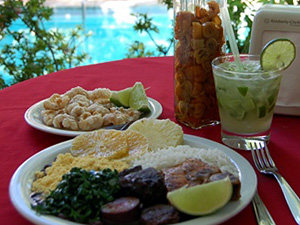- Top 10 Brazilian beachesPosted 11 years ago
- Top 10 female celebritiesPosted 11 years ago
- Top 10 Brazilian cocktailsPosted 11 years ago
- Top 10 Brazilian snacks: SalgadinhosPosted 11 years ago
- Top 20 Brazilian cigarsPosted 11 years ago
- Top 10 best snorkeling locations in BrazilPosted 11 years ago
- Brazil’s best coffee: Bourbon SantosPosted 11 years ago
Brazilian national dish: Feijoada
 Feijoada, a flavorful stew of beans and pork, is called the national dish of Brazil. Typically served at noon on Wednesdays and Saturdays, this hearty meal is a thick mixture of beans, fresh and smoked meats plus seasonings. Feijoada is such a heavy dish that the only recommended activity after eating is napping. Also, it’s recommended to wash it down with caipirinha.
Feijoada, a flavorful stew of beans and pork, is called the national dish of Brazil. Typically served at noon on Wednesdays and Saturdays, this hearty meal is a thick mixture of beans, fresh and smoked meats plus seasonings. Feijoada is such a heavy dish that the only recommended activity after eating is napping. Also, it’s recommended to wash it down with caipirinha.
A popular myth states that the Brazilian feijoada was a luxury dish of African slaves on Brazilian colonial farms, as it was prepared with relatively cheap ingredients (beans, rice, collard greens, farofa) and leftovers from salted pork and meat production.
However, historians consider that feijoada is a Brazilian version of stews from Southern European countries and traditional Portuguese bean-and-pork dishes (cozidos) like those from the regions of Estremadura and Trás-os-Montes are the ancestors of Brazilian feijoada. The earliest printed references to the dish appeared in the mid-19th century, based on menus of upper-class. Source: wiki.
It has evolved to include Portuguese and native Indian influences. Nowadays it is elaborated with many different smoked and sun-dried meats, smoked sausage and served with a number of side dishes, including sliced oranges, cold cuts, farofa (stir-fried manioc flour), couve mineira (thinly sliced kale) and white rice.
 The name is derived from the Portuguese word for bean, ‘feijão’. Black beans are most commonly used, but depending on the region, feijoada can be made with any dried bean. Some regional feijoadas may be accused of not being the ‘true’ feijoadas, i.e. Feijoada Completa, as the peoples of the various regions use whatever local produce which is available, but whatever the modifications, the basics are the same.
The name is derived from the Portuguese word for bean, ‘feijão’. Black beans are most commonly used, but depending on the region, feijoada can be made with any dried bean. Some regional feijoadas may be accused of not being the ‘true’ feijoadas, i.e. Feijoada Completa, as the peoples of the various regions use whatever local produce which is available, but whatever the modifications, the basics are the same.
Here a simple recipe for feijoada as approved by a Brazilian feijoada restaurant.
Ingredients
1kg of black beans
250 g of dried beef (“carne seca”)
250 g of salted pork ribs
100 g of smoked loin of pork
100 g of smoked bacon
1 pork trotter
1 pork tail (or ear)
2 large pork sausages (“paio”)
1 Portuguese sausage
1 onion
3 cloves of garlic
1 soup spoon of olive oil
2 bay leaves
1 orange
Preparation
The night before, clean the pork trotter and tail and soak them in cold water together with the already cleaned pork ribs. In a separate bowl, soak the dried beef cut into pieces. Change the water in each bowl at least four times.
Put the salted meats on the stove in a pan with plenty of water. Boil for 10 minutes, drain off the water, pour in clean water and cook. Use the same procedure for the dried beef, putting it to cook in a separate pan. When the meats are tender, but not shredded, drain off the water and cut the pork ribs into pieces. Set aside.
Cut the “paio” and Portuguese sausage into thick slices, the smoked bacon into small cubes, and the smoked pork into medium-sized cubes.
Place the beans in a large pan with a thick bottom. Add water, the bay leaves, and the orange cut in half, with the inner peel but without the outer peel. After cooking for 45 minutes, add the salted and smoked meats, the dried beef, sausage and “paio.” Leave to cook for 20 more minutes.
Remove two soup ladles of beans from the pan. Chop the onion and garlic finely. Sauté them, without letting the brown, in a skillet in the olive oil. Add the bean paste to the skillet and cook for two minutes. Return the entire mixture to the large pan, mix and taste for salt. Adjust the temperature as necessary and leave everything to cook 20 minutes more or until well cooked.
The meats can vary according to individual taste. It is very important that the oily build-up on the surface be skimmed off periodically while cooking.

Pingback: Soccer Games & Vila Velha State Park Discoveries | Beyond My Fence
Pingback: 9 SIGNS YOU’VE NEVER EATEN REAL BRAZILIAN FOOD | How to travel light